The history of New York bespoke tailoring: An introduction with Bruce and Alan
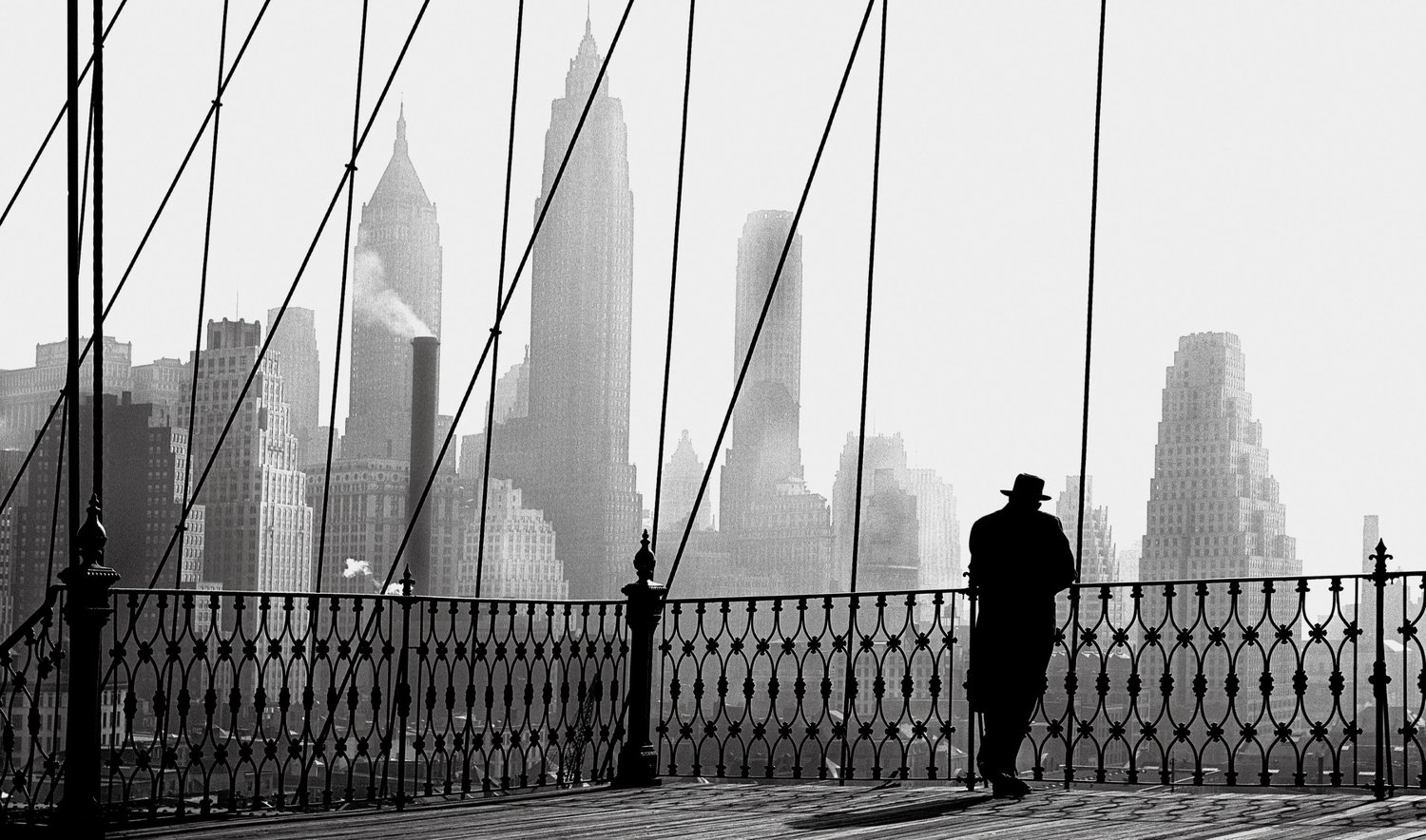
* This article is the first in a series that will look at New York bespoke over the years*
By Manish Puri.
In the 1956 version of the song New York’s My Home, Sammy Davis Jr. is eager to address the crazy rumour that some foolhardy New Yorkers are considering leaving town. He concedes that Chicago is “alright” and is willing to accept that San Francisco “is a lovely place”. But, in a rattling and light-hearted smackdown, he makes it known what all those other cities lack:
“It hasn't got the hansoms in the park / It hasn't got a skyline after dark
It hasn't got the handy subway train / You seldom find a taxi when it rains
It hasn't got the opera in The Met / It hasn't got a famous string quartet”
And that, ladies, and gentlemen, is why New York is his home, sweet home.
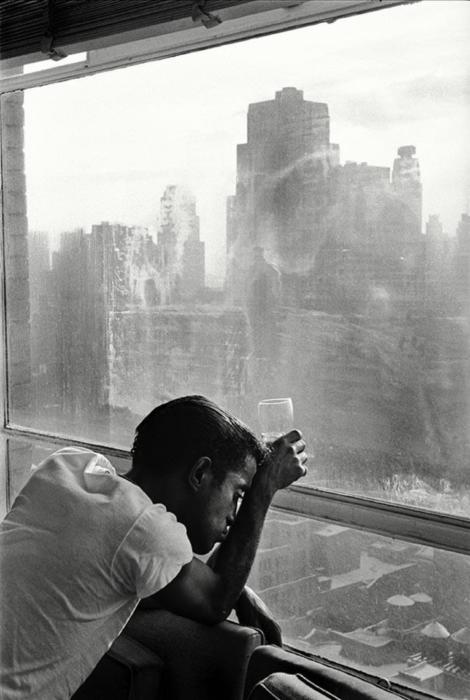
However, one thing Sammy doesn’t list as a virtue of New York is bespoke tailoring.
Now that could just be because it’s very difficult to rhyme “it hasn’t got a well-established, diverse range of artisans making quality bespoke.”
Or it could be that this magnificent metropolis (and, by the way, if the medical community ever wanted definitive evidence that a person can be literally bored to death, just watch me to talk to someone for an hour about how much I love New York City), relative to London at least, doesn’t have the bespoke tailoring history, the longevity of names, or the sheer weight of numbers one might expect.
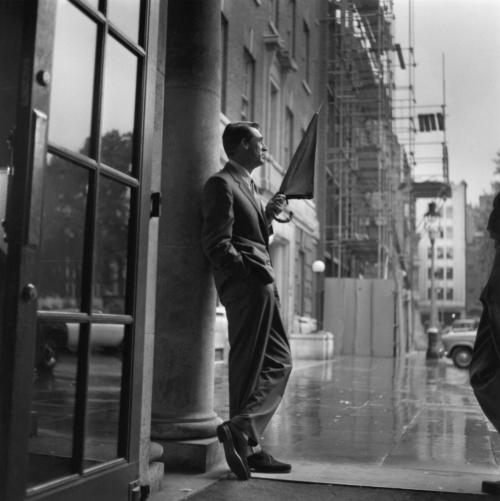
Which, of course, isn’t to say there weren’t (or aren’t) brilliant craftspeople forging their own identity and style in the New World. It’s just their stories are afforded less prominence than those of the houses of Savile Row or the sartoria of Naples.
I’d like to help address this through a series of articles that will dive into the history of New York bespoke– a continuation of a process Simon began with this compilation of tailors working in the city today, and, more recently, his bespoke review of Paolo Martorano. In future pieces, I’ll look in detail at some of the most venerated.
However, to help set the scene, we could think of no better authorities than G. Bruce Boyer and Alan Flusser who were most generous in sharing their recollections of the scene, their take on who some of the most influential names were, and what remains today.
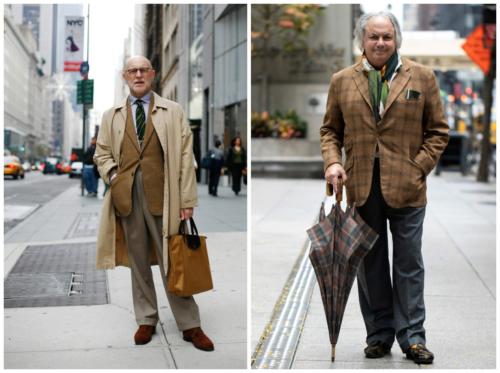
On the scene in its heyday
Alan Flusser (AF): Like any menswear capital, while generally deferential to all things Savile Row, Manhattan was host to a lively community of European-trained bench tailors as well as those bred on the East Coast carriage trade. The sixties saw many of them retire as upstarts like myself came onto the scene.
Bruce Boyer (BB): I came on the New York scene in 1973 when I started writing for Town & Country about men's clothing. The majority of tailors were Italian, with a few British representatives.
On the options for a sartorial man about town
AF: Those was the days when a typical, sartorially capable male would have started at Brooks Brothers and gotten that very, very special grounding in taste and attitude about the way clothes should look and feel.
And then Paul Stuart was the next step because, in the sixties and seventies, they made shaped clothes – which women loved because it made men look sexier and thinner and younger.
And then the question of where you were going to go next, depended on the personality of the person. You were either going to get something custom made or you were going to wear a Pierre Cardin suit (who I worked for in the early seventies). It wasn’t as good quality as Brooks Brothers or Paul Stuart, but it had cachet, it had a look to it.
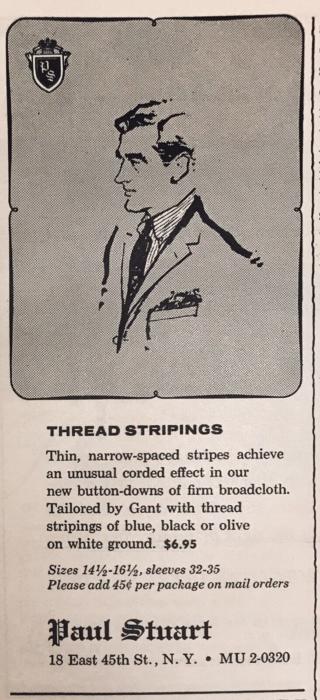
On the most celebrated names of New York bespoke/custom
BB: At that time, and over the next half century the most significant names in individualised tailoring were William Fioravanti, Morty Sills, Piero Dimitri, Henry Stewart, Dunhill Tailors, Roland Meledandri, Leonard Logsdail, Bernard Weatherill, Alan Flusser, Vincent Nicolosi, Cheo, Mimmo Spano, Nino Corvato, and Gilberto.
Of course, Spano and Flusser were not tailors, they were stylists, but Alan probably introduced more men here to personalised clothing than anyone, and Mimmo Spano started off working for Alan.
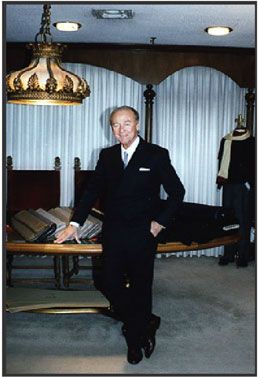
On William Fioravanti
BB: Bill Fioravanti was the most expensive (if he were in business today, his suits would probably start at about $10,000) and most successful tailor in NYC, with the largest number of tailors on premise, around 20.
His house style was similar to what Brioni in Rome was doing in that period. In the early seventies he designed what was called The Power Look, an architectural silhouette streamlined to a hard glamour with straight, high shoulders, a close waist and hipline, narrow sleeves and trousers. It was very clean. No wrinkles were permitted to mar the image of complete confidence for the successful executive businessman.
AF: Very charming guy. Bill made handmade clothing, but not in the tradition of England, in the tradition of Rome. And Bill's bailiwick was that he made very fitted clothes - Italian fitted clothes – with an overall purpose to make somebody look thin. So, clothes were cut in such a way that they gave you a much leaner line to everything.
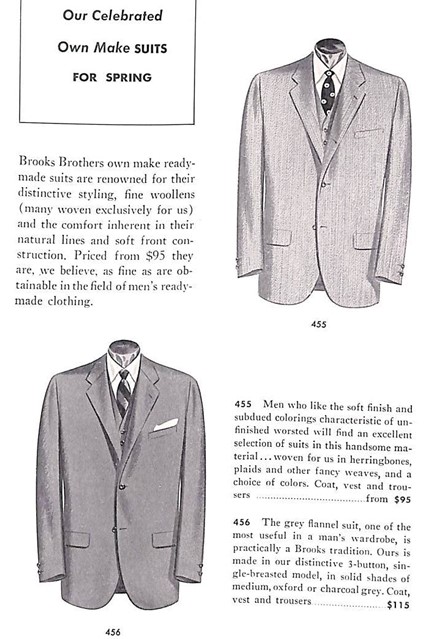
It wasn't a place that, by Hollywood or men's fashion standards, you'd think well-dressed men go, because it butted up against traditional American notions (from Brooks Brothers) that you don't want to see a guy who's been compressed into a suit and there's no wrinkles, etc. So it was a style of clothing that kind of fought, to a degree, with traditional American architecture.
But the quality of what he made was legitimate. And especially in the early days, you couldn't buy a ready-made suit that looked like that - nobody was selling it.
BB: A few years ago, I was in Bill’s atelier, and one of his customers came in - this guy was the president of a very large American bank. He said to me, "Mr. Boyer, do you know why I wear Fioravanti's clothes?" I wanted to say, "Because God gave you too much money?" But I didn't, I said, "Why?” And he said, "Because when I walk into the boardroom, I want everybody to understand, even before I open my mouth, who's in charge here. And his clothes do that for me." There was a great truth in that, all the way around.
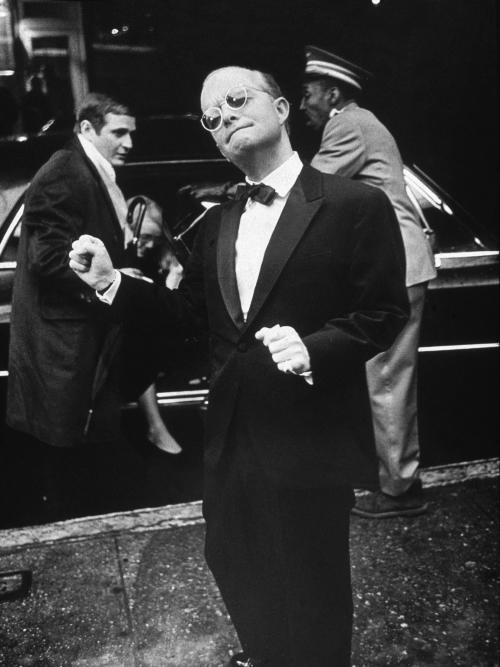
On Dunhill Tailors
BB: Not to be confused with the English firm of the same name – Dunhill Tailors was run by two brothers from Pennsylvania. They made a good team because one had the better eye for design and the other for business.
Dunhill Tailors was popular for almost half a century with the EEE (Eastern Elite Establishment) who wanted no-nonsense tailoring of high quality and tasteful styling. The house style was mid-Atlantic, a bit of Ivy mixed with a bit of British and characterised by a middle-of-the-road philosophy of everything in moderation.
Quiet yet stylish, well-made, well-fitted garments that spoke softly but carried a lot of weight.
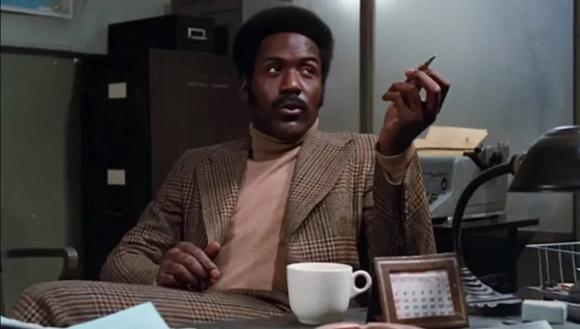
On Morty Sills
AF: Morty was this very avuncular and down-to-earth man. He had the young Wall Street, Master-of-the-Universe guy. And, as a matter of fact, even though I did the clothes in Wall Street the movie, I think Michael Douglas tells Charlie Sheen to go to Morty Sills and get some clothes.
BB: Morty became an iconic name in town among young executives who wanted something a bit more sophisticated than Ivy style. Morty once told me his ideal was Fred Astaire, and he more or less copied Astaire's look: an Ivy-styled coat but with subtle shape, small extended shoulder, soft chest and nipped waist, flared skirt with side vents, moderate lapels and sleeves that tapered at the wrist.
AF: He was a Fred Astaire-phile because he looked a little bit like Astaire, same body. He liked fitted clothes, a natural shoulder type which a lot of people were starting to experiment with. Paul Stuart had introduced a soft shoulder, two-button coat - that was a big deal. Ralph Lauren was also coming on with a soft shouldered, fitted coat.
BB: It was a hybrid of Savile Row and Princeton, taking the best of both and constructing a comfortable, stylish, and slightly casual look; an elegantly balanced silhouette, nothing over- or under-wrought. He had a clientele of young lawyers, stockbrokers, entrepreneurs, and a few confident celebrities who would have shopped at Dick Carroll's if they were on the West Coast.
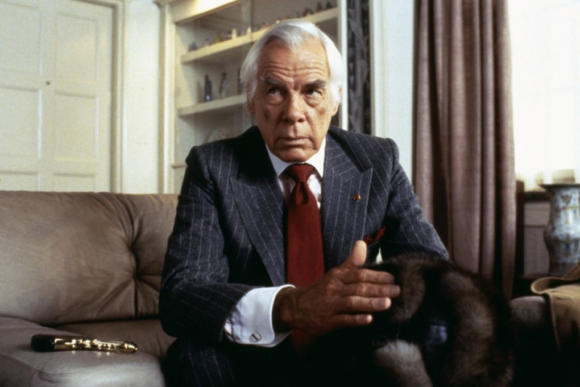
On Henry Stewart
AF: Henry was probably the most traditional tailor out of the conventional Savile Row experience.
And he had very trained Savile Row taste. That means that he understood, as an example, if you made a Glen plaid black and white suit, you used grey thread that disappeared - that's a Savile Row trademark. As opposed to America, where, if we had a black and white coat, somebody would put on a black buttonhole and then you'd be able to see the buttonhole.
BB: Suits were upright and well-constructed, shaped with layers of infrastructure and made to stay that way. Stewart was surgically adept and knew all the tricks, all the ways of giving a man whose shoulders were shaped like a burgundy bottle a square cut silhouette and give a concave chest some muscle.
He once showed me a coat he'd made for a man who had a hip removed; the one side pocket had been lined with extra layers of cloth to fill in the missing space.
AF: He had an interesting way of drumming up business. He would periodically declare that he was retiring - like a Rolling Stones farewell tour. Everybody understood after two or three times that probably wasn't going to happen, but they would buy a suit.
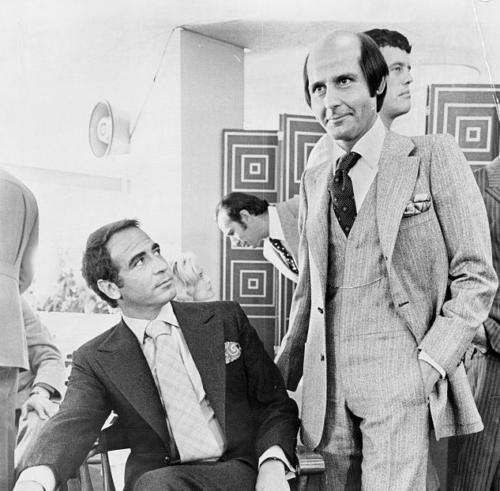
On Roland Meledandri
AF: Roland Meledandri was his own invention.
He made wide-lapel suits, long or even open collar shirts, and wide ties. And this guy, who was literally pencil thin, was wearing clothing which fit within an inch of his life. But the proportions of the clothing were completely different to where everybody else was going.
BB: Roland may have been the most influential tailor in NYC in the second half of the Twentieth Century, if for nothing else than - and this is an oft-told tale in the NY garment district - that he inspired Ralph Lauren's favourite coat silhouette.
AF: Roland was kind of the model, at the time, for what Ralph became (and in my book, Ralph Lauren: In His Own Fashion, I think I devote a half a page or so to Roland). He was really the first designer, because his look was a designed look. He had real taste - it was a little bit more Italianised than Ralph, who was more Anglified. And he was the first person to feature Ralph's ties at retail.
And, to a certain degree, he was a model for my own custom tailor business. Cause he was a guy who didn't come from menswear, but you looked at him and you just wanted to dress like him.
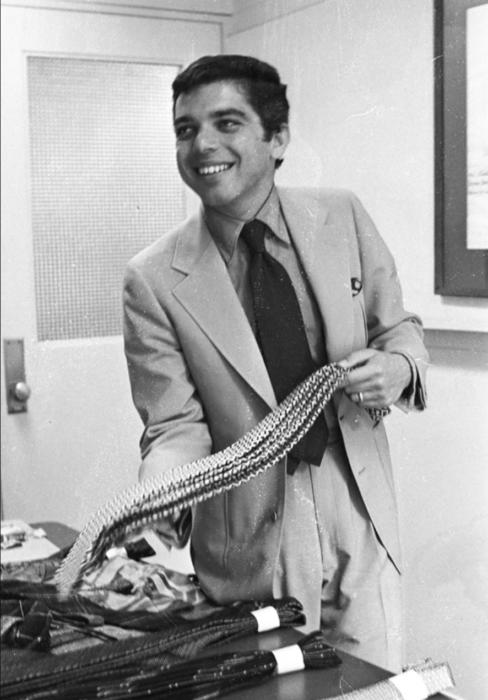
BB: Roland hated the understated campus clothes of the Old Wasps and developed his own sense of what sophisticated guys should wear, based on influences from Fred Astaire to Mr Fish. He liked wider ties and colourful shirts with larger collars, colourful tweed jackets and bold-striped flannel suits in winter and gabardine suits in summer.
He took a trad coat and lowered the two-button stance, widened the lapels two inches, deepened the vents the same amount, nipped in the waist and flared the skirt, and straightened the shoulder line a touch for a more rakish look. Trousers were narrow and pleatless, some had Western pockets.
AF: Walking into Roland’s was really, for some people, like walking into 346 Madison Avenue at Brooks. I mean, it was really the centre. I think probably the only reason Roland didn't become much larger was that he didn't give a shit what you thought. It was his way or the highway. And his way was generally the right way because he had created this look.
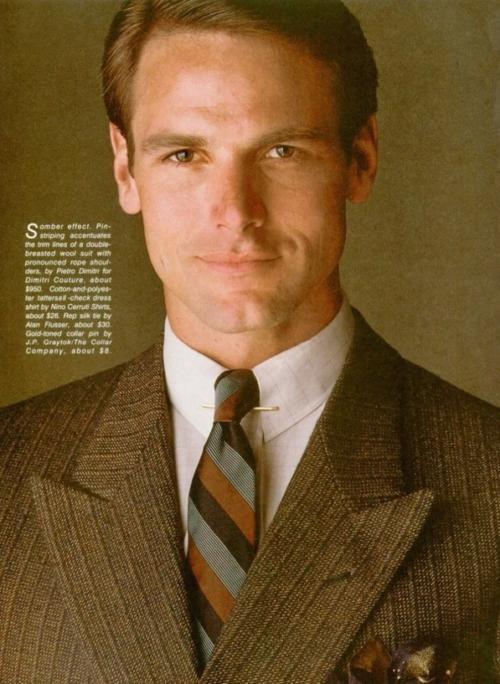
On Piero Dimitri
BB: Piero was a young Italian tailor, from Sicily I think, who brought a decidedly fashionable approach in Manhattan. He preferred to cater to high-end celebrities - I once had a nice chat with Robert Evans, the film producer, at Piero's atelier - who weren't afraid to order a dozen jackets or suits at a time.
The house style was narrow and lean with a small soft shoulder and chest, the body narrowing to a close waist and hips. Sleeves were narrow and the preferred style was minimalist with no pocket flaps or vents. Trousers were narrow, Dimitri liked full top pockets and a low-slung waistband.
It was styled closer to what the Neapolitan tailors of the day were producing. Elegant, youthful, and international haute couture for men with taste and money.
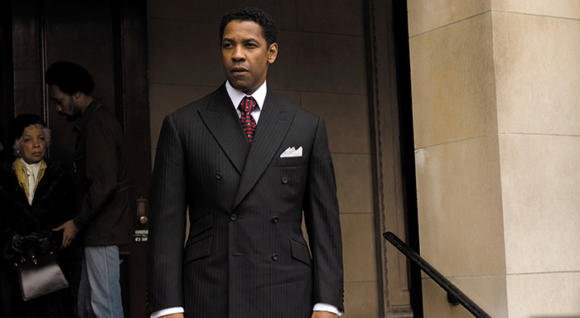
On Leonard Logsdail
BB: Leonard is a London-trained tailor who came to NYC in the last quarter of the Twentieth Century and has carved out a spot for himself as the most prestigious bespoke maker in town, we might say in the whole country.
The house style is quietly tasteful and Mid-Atlantic, the beauty being in the subtlety of shaping and design. Shoulders are moderate and imperceptibly sloped, waists are curved inward and skirts gently flared outward, sleeves unobtrusively tapered, the coat's middle button sits at the waist and the lapels widen to the perfect pitch and width.
He also has something of a specialty with gentlemen who want hunting kit such as Norfolk tweed jackets with plus fours and shooting cape or waistcoat, for that little shooting box in Scotland or somewhere in Texas.
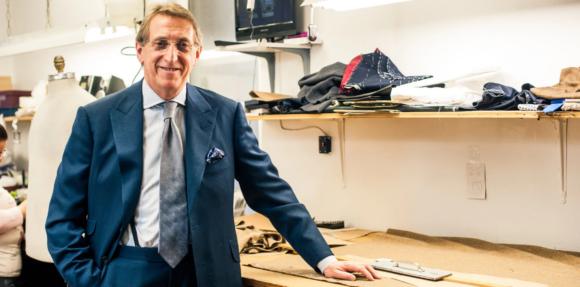
On who remains
AF: Most of the tailors we're talking about were older - sixties. So, they were coming to retirement around the same time as this casualisation of clothes occurred.
And most of the tailors didn't have a feel for fashion. They were people trained on a bench and from a working-class background. They were set up to do classic, Savile Row-esque clothes. The idea of making something that didn't have a structure or making shirt-sleeve shoulders - it's just not something they knew. Even if they knew how to make it, they didn't understand what kind of fabrics they needed.
BB: Apart from Logsdail, none of these men are left. If the name is being used, the business has changed. This is inevitable because great tailoring firms are made by great tailors, tailors not only of incomparable skill, but of vision and personality.
The vision comes into play when the tailor sees the style of the zeitgeist before him. When he understands how his potential customers want to appear, when he can translate their dreams of themselves into cloth coverings. For the past 50 years more and more men (and some women) who think about such things have gone into design rather than craft.
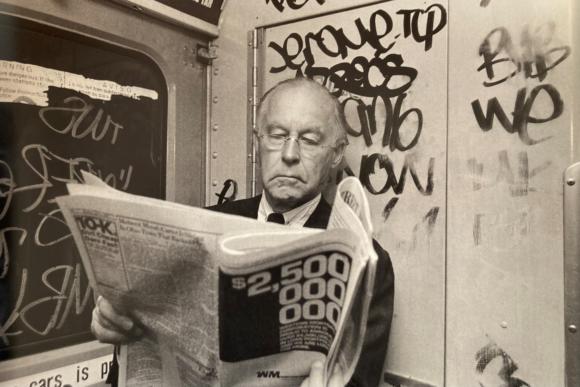
Bruce Boyer’s new book RIFFS: Random Reflections on Jazz, Blues and Early Rock is scheduled for publication in late spring/early summer.
Alan Flusser’s most recent book Ralph Lauren: In His Own Fashion is out now.
Manish is @The_Daily_Mirror on Instagram




























‘It hasn’t got tailors making fine bespoke / cutting nice suits for the stylish folk’ ???
With apologies to Sammy Davis Jr… this looks to be a great article but I had to come and write this down before I finished it
Super article. Love the cartoon at the end. A very familiar feeling after 4 years on the F-train.
How about New York tailoring on the first half of the 20th century, romantized in movies ?
We can cover that separately PA, sure. This is more focused on recent decades
Rather timely and very interesting article.
I’ve recently come across an online brand offering the drape cut called ‘Ask Okey’. If I could , Simon, recommend some of their Youtube videos offering some good understanding of the drape cut.
A few years ago I would have dismissed such cuts as too boxy , too much drape but, rather as Simon mentioned in an article recently , as you age you appreciate more comfort over fit. I finally understand Bruce Boyer and Alan Fusser’s looks now . Previously, I’d admire their sense of colour and patter mix but couldn’t understand their rather ‘loose’ look.
I’ve also noticed that once your eyes attune to a drape fit every previous fit you’ve seen looks small . Rather like its shrunk in the wash or an oversized school boy look.
Understanding ‘rules’/ proportions such as the trouser hem should be 2/3 the size of the shoe has pushed my understanding of tailoring to another ‘dimension’.
I wonder if PS would consider a review of AskOkey (I declare no financial or other interest in the brand). Particularly, as it’s exclusively online (but price-wise at the same point as premise-based tailors).
I look forward to future articles on New York tailors.
Dear Robin, I’ve been a PS visitor for many years but somehow missed your comment. Indeed the Drape Cut is highly misunderstood by many. Often associated with the American Sack Suit, it is in fact the antithesis of the Sack Suit. The Drape Cut is in fact more shapely than your typical Continental European Cut. Why? Because the Garment is a STRUCTURE built apart from the wearer. The roominess in the CUT means that it can, and often is SHAPED. Extreme in some cases but not with our AskOkey Cut. Ours is a SUBLIME cut and harkens back to the days of Edward the Duke of Windsor and his coat maker Frederick Scholtz. I certainly would welcome the opportunity to share our Drape Cut and Philosophy behind it with Simon Crompton and PS.
Best wishes, Okey (Founder, AskOkey Inc.)
Splendid article. Something I knew nothing about.
Very interesting quote about people moving from craft into design. It’s what happens when practical skills are moved into academica. It’s happened with photography,and,I imagine, journalism.
Fantastic article and pictures, Manish.
Is Roland Meledandri wearing a trousers-waistcoat ‘onesie’ (for want of a better term, perhaps), or do mine eyes deceive me?
Thanks very much, Will.
Yes! I think so too! Either that or it’s the cleanest waistcoat-trouser line in history.
I thought so too. IIRC Henry Poole made onesie suits for Winston Churchill which he wore in the Cabinet War Rooms close to Downing Street. Perhaps that Churchill’s was the inspiration for Roland’s who must have had a lot of self confidence to wear it when meeting clients.
Thanks for this article and interview. Absolutely passionating. We need more article like this, really bringing depth and knowledge.
I think the man looking up at Roland Meledandri is the actor Richard Conte. Meledandri might have been bigger & better known had he not died of a heart attack in 1980, aged only 51.
The seated customer looks like Richard Conte, but it isn’t. Conte was much older at that time. He played tough guys on the 1940’s and 1950’s. Ironically, he is best known for one of his last roles as Don Barzini in “The Godfather”.
the seated gentleman is Dan Melnick, a notable Hollywood producer and studio head…and if i’m not mistaken the man bending down in the bg is Madison Ave legend, George Lois…both Dan and George were longtime Meladandri clients…
Simon,
Well written article, if not somewhat sad for us Americans. Still, going to NYC for tailoring is still the most practical option to east coasters like me.
As you’ve written previously – simply putting effort into your wardrobe and presentation will make you look better than 99% of the men around you!
Best,
Robert
Post-Covid you’ll have a hard time getting a taxi in the rain in Manhattan, too.
This is a great interview. However this is a history of NY bespoke tailors in _living_ memory. The true heyday of NYC bespoke tailoring was during the era of the great fifth avenue tailors, tailors that flourished long before Boyer and Flusser were around. Tailors such as Twyeffort, James W. Bell, Gray & Lampel, Wetzel, Schanz, and others flourished from the late 1800s and started declining during the 1930s. During their peak, these tailors charged more than the Savile Row tailors and were heavily used by the Wall street elite. However once the Great Depression hit, they were seen as non-unionized lackeys of the idle rich and the midwestern look (plain, sober off-the-rack suits) took hold. I believe most were gone by the end of the 1950s (or maybe 60s) – a few names were left into the 2000s, but were little more than names.
Thank you, yes it was a point made above. Could also be a nice piece at some point
The senior partner at my law firm died a few years ago well into his eighties. I helped his family with donating his suits to those transitioning out of their jail terms. I counted about 40 Gray & Lampel suits that we donated. Would love to run into someone in court wearing one of his suits.
I just came across this exhibit of past clothing posters for both men and women. We’ve definitely gotten more casual! https://chisholm-poster.com/show/the-art-of-style
Truly a great read, thank you for sharing/putting this together!
An interesting article with some nice reminiscences. I always enjoy these pieces covering the history of menswear. If I may suggest a minor revision to the text: the final section of the article should read ‘On who remains’ not ‘on whom remains’ as it forms the subject, not the object, of the sentence.
Thank you Andrew
This was absolutely epic
I have my own experience of New York tailoring and its cultural influence which is worth a mention. My late father was a merchant seaman working between his hometown Liverpool and New York for Cunard (and others) in the 50’s and 60’s. He told so many stories of bringing tailoring and jazz music back to Liverpool that it compelled my cousin to write about the influence of ‘Cunard Yanks’ on popular culture in Liverpool which ultimately became a documentary that aired about 10 years ago. My dad used to guest lecture at the Maritime museum in Liverpool for a time. He was the best dressed man in Liverpool (according to my mum). Interesting that it was New York not Savile Row that was a greater influence because of the gateway potential of a major port.
https://www.liverpoolecho.co.uk/whats-on/tale-cunard-yanks-who-created-16003677.amp
Wonderful, thanks Liam
Great article for a topic i didnt know much and made me think about the tailoring evolution over time. Simon or Manish or readers, what do you think about the stoffa soft tailored clothes ?
I’ve tried them but don’t own any. They’re beautifully styled and the fabrics are great, but they’re too like a jacket without having the fit or any structure, for me personally. I can imagine they might be good for someone that doesn’t wear tailoring normally, perhaps
BB “Apart from Logsdail, none of these men are left.” Is he saying that they are all dead or are some just retired?
I had expected Frank Shuttock to get a mention. He moved from NYC to Henderson, around 300 miles north, a few years ago. He’s an American tailor whose house style is old school Italian like those he trained with. I believe that Frank, like Des Merrion in Yorkshire, cuts and stitches everything personally. Perhaps he’ll be featured or profiled in future articles
Hi Gary,
The piece is not about current tailors, that’s this piece here, which Manish also refers to. It’s just that Len has been around long enough to crossover between the two.
See comments below on Frank himself.
Hi Gary
With the exception of Len, all of the tailors discussed in more detail by Bruce and Alan have passed away.
Simon,
Would suggest you reach out to Frank Shattuck as a follow up to this article. Genuine NYC benchmade tailoring still going strong.
S
Thanks S, yes I’ve had quite a few conversations with Frank over the years. He even made me a basted fitting just for the hell of it. His location does make it a little hard to prioritise for making up something to cover though, especially as there are more proper bespoke tailors from the UK in New York now, plus of course all the ones who visit
I believe Frank has developed a remote fitting service that may be of interest for a review. I have contacted him and he sounded quite pleased with the results he has been able to achieve using this method. I have not started the process with him in earnest yet but plan to at some point in the future.
Thank you David. Yes that was the reason he wanted to try out a remote baste on me I believe.
Hi Manish,
Thank you for another illuminating and humorous article. Regardless of the subject, I always enjoy your articles even as in this case I where less relevant to me, I always like to learn.
On a slightly related point, There is a film that you and readers may find entertaining. It’s called The Outfit starring Mark Rylance. It’s about a Saville Row tailor who relocates to the US and centres on his relationship with a crime boss. It’s staged more like a stage play than a film. A bit niche but I think well worth a watch.
Thanks again
Thank you so much, Stephen! I’m so pleased to hear that.
I always appreciate a good film recommendation too, thank you.
Whenever I have seen photos or film of Leonard Logsdail his suits and shirts always appear oversized. Those he makes for clients have a more conventional cut. But Leonard’s own suits seem baggy. It’s not simply drape, it’s far more exaggerated. More similar to 1980s Armani. I find it interesting that his own style is so different to the style that he cuts today. Whereas most tailors would wear what they are making now in order for the customer to see what the house style is.
This is an excellent article, a trip down memory lane.
Nino Corvato retired and sold his shop to a Tapia. Corvato is either fully retired or semi-retired. https://www.sleevehead.org/2021/05/nyc-tailor-nino-corvato-retirement.html
Is Cheo still working? One never hears of him.
I believe that Gilberto Designs mostly does work for stage, film, and television. This has taken-up the slack of diminishing work from the traditional suit wearing males, such as businessmen, professionals, etc. I know of another two makers who have stepped-up their entertainment work.
Really Interesting article Simon Thanks
One wishes more of these forgotten tailors had survived but that is life…… Apart from Leonard Logsdail I did not know one name…..
In my opinion ( Lee Marvin and Truman are wow!)” American “fashion clothing tailoring combinations were always distinctive in the way it was and is worn and I believe the influence that Americana or Ivy on the way men dress is unsurpassed.
We all are Ralph’s babies in a way……
That was a lovely read over tea, shortbread and sherried Scotch. I hope you may feature “heartland” tailors one day, which must certainly be an interesting sartorial facet of US immigration history. That just comes to mind as I’m wearing a suit made in St. Louis in the 1960s by Salvatore Cippola, from British cloth in a North Italian style.
Well done, Alan and Bruce .
Each has, and continues to, study and speak authoritatively of men’s tailoring and haberdashery in the US market.
There are many of us who’ve been enriched by their telling of the players over the last, dare I say it, 50 years. We appreciate their dedication to the craft.
Don’t stop now!
I am surprised you did not mention Chipp and my father Sidney Winston. He was a true innovator and Chipp made all it’s own custom clothing.
Among the Chipp customers – The Kennedy, DuPont, Rockefeller,Watson and Ford families.
I closed the clothing business in March of 2020. I still our tie company.
I’m honored to be included in this article and have my name mentioned alongside such great tailors as Bill Fioravanti, a personal friend.
When I moved from Savile Row to Madison Avenue in 1991 I thought I had checked every box in preparing for this life-altering move. But the one box I hadn’t even thought about was knowing I could walk down the street to any SR tailor and ask advice. I was stuck on a fitting and desperately needed assistance. Bruce Boyer suggested I call Billy. I was invited to 57 street where he freely gave me 3 hours of his time to work through my problem. We soon realized and respected our similar talents and a fast friendship flourished between us.
Our styles were completely different, he dictated to his clients the style they should have. I listen and advise. I realized at a very young age that the suit I am making is not my suit, it’s the clients. I’ve made many suits not to my personal taste. But when I see a smile in the mirror at the final fitting I know I’ve succeeded
It’s the same with my movie work. The suits I make are at the direction of the costume designer, my immediate client. The actor and I are only tools to achieve the desired look in the desired era. And that’s the fun of it
Some people work for money. And I understand the need for money. But what tied Billy and me together was the love of our craft. The money came if we did our job correctly. I think this genuine love of making clothing is what cemented a wonderful friendship
Leonard logsdail
Leonard Logsdail is as fine a gentleman as I’ve met in the trade. I recall visiting with him in his Sackville Street atelier where he partnered with Brian Burstow. This would have been in the mid 1980s before he made the leap to NYC, and where he’s enjoyed well-deserved success. Good show, Leonard.
It’s funny you say that Len, I’ve always been of the view I want to make the garment I want to make, that’s the two different approaches though. If I didn’t have confidence in what was being turned out I wouldn’t put my name on it. Not a swipe just an comment.
I am a client of Alan Flusser, and now, Jonathan Sigmon has taken over. They are gravitating more to MTM. During the pandemic lockdown, Alan and I had many email exchanges on fashion, mutual friends, his growing up in West Orange, New Jersey, and Saturday visits to Brooks Brothers with his father. His dad was in the commercial real estate business, so he dressed smartly and conservatively. I clearly grasp how Alan’s clothing excursions with his dad shaped his future style chops. I only wish Alan were still engaged in the business; he still has so much yet to offer. Cheers,
I have two suits and two sport coats made by Fioravanti in the early 1990’s. They were beautifully made but alas woefully out of current style. They are all ventless with heavily padded shoulders so they all get little if any use. The Leonard Logsdail suit that I have is not as well made as the Fioravanti. It is a more modern style but it does have a roomy “drape” cut unlike the short slim cuts still currently in favor especially with younger men.
Thank you RTW, great to have the personal input
That suit Denzel Washington is wearing by Logsdail in American Gangster is it for me. I would love to get into one like that! The way the sleeves taper and how natural it fits and hangs. It’s double breasted and it does feel like it, it doesn’t looked forced just natural. Very nice article, thanks so much.
I don’t understand how Alan Flusser can be a style icon and be interviewed about this subject and be photographed in the most Ill fitting pants of all time. Brutal.
We’ve talked about this a fair bit in the past Tom, but whatever you think about how Alan dresses, I don’t think that really has much impact on what he writes about his recollections of tailors
Americans…
Alan Flusser and Bruce Boyer are excellent excellent gentleman. Alan gave me my first job in New York and introduced me to my Maestro, Raphael Raffaelli. I owe Alan for the knowledge I learned from Raphael. And Bruce Boyer is one of the nicest down to earth gentleman around. He did an excellent article on Henry Stewart for “Town and Country”. Worth digging up. Nice to see these great tailors remembered.
I was very pleased to see mention of the American Dunhill tailors, I have an old, 60s I think, houndstooth cashmere jacket from them, American soft with English vents and a little shape, Ralph before Ralph?
Bill Firovanti’s business card actually said “if you have to ask the price, you can’t afford me” #legend
fantastic, thanks very much
Hi Simon. I’m in need of some smart/casual trousers and looking to something like the officer chino from Rubato or the 1950s chino from The Real McCoys, something which wears well with both loafers and sneakers. However both are not cheap, and I am a slightly odd shape in that my thighs are proportionally bigger and I find it hard to find good fitting trousers, with room in the thigh, comfortable to sit in and a taper at the bottom. With that being said, would you recommend perhaps going bespoke? And if so would there be any tailors you recommend, I assume they would be similar in price as the TRM chinos for example – £430.
Sorry for the long question and thanks!
Hey Ben,
The 50s chino from Real McCoys is certainly generous enough to fit you, but it is quite a period style – big legs, high rise.
The Rubato chino is quite a good fit for that kind of body type, but it depends how extreme you are in that regard. Certainly, they will fit better than the vast majority of mainstream trousers for your shape.
Bespoke chinos are rarely a good idea – they don’t look like chinos. Lots of detail on that here.
But if you want something smarter, then a made to measure trouser is certainly a good idea. Somewhere like Anglo-Italian would be good for that.
Great article.
Just one further comment.
Custom clothing was also sold in stores which mostly featured RTW.
For example,
I assure you working class people can have style, some just don’t wear it on their sleeve and prefer the work to speak for itself. Aristocrats have never ever made clothes.
Roland Meledandri sold me the first suit I purchased by myself at the age
of 15 in1956. I forget whether it was from Casual Aire or Men’s Town and Country,
two shops in Greenwich village that were riding the Ivy Tide, but with a difference-
a bit more “dash” .At the time Meledandri wore 4 button suits and sported a handle bar
mustache. My father who dressed very traditionally,at the time from Rogers Peet, approved
of my choice. This did not end his shopping with me, which he enjoyed. My next suit
came from Paul Stuart, where my dad had started getting his clothes and already
had “his” salesman, an elegant man named Murray…. I do not recall his surname.
When I became an “adult”: and had some money most of my clothes came
from Chipp.
The best tailor I am sorry to say was a man known in the industry of fashion by one name. He was the chief executive tailor in charge of alterations at Barneys New York. He was known to all as Sonny. He made Barneys. With out him the thousands of expensive suits purchased every day would not be altered.
Can anyone tell me anything about ‘Vincent Costumes New York Inc’? I have in my possession a tailor made suit that was made for the British ice skater, John Curry who spent much of his life in New York in the late 70s and 80s. I’m trying to find out more about the tailors but no luck so far.
My Father was a Fioravante Tailor. His name was Alfred Arbore. Dad also tailored for The House of Maurizio and Dunhill Tailors. He came to NYC, as a boy, from Bari, Italy. His workmanship was impeccable and precise. Perfectionism went into every stitch and he was one of the best in the industry. I remember well, the high pressure my father was under, to deliver a handsome product to Mr. Fioravante, and he always succeeded. What a privilege it was to witness the workings of this unique and wonderful Bespoke industry, from the inside.
Wonderful, thank you for commenting Denise